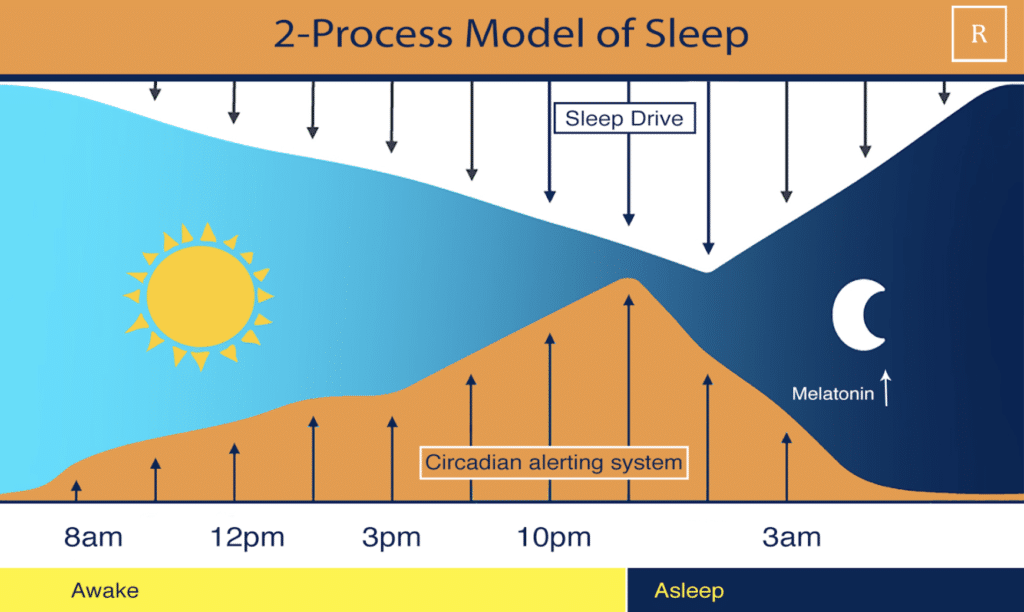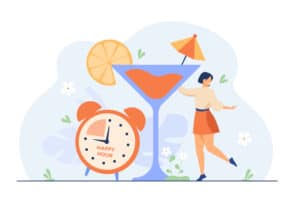
THE BOTTOM LINE:
Your sleep drive is your body’s need for sleep
Sleep pressure builds during our waking hours and resets during sleep
Your sleep drive works with your circadian rhythm to produce a healthy sleep-wake cycle
Every person in the world understands the feeling of being tired. Have you ever wondered why you feel tired at the end of the day? There are a couple of processes at work, but one of the main ones is your sleep drive! As you may have guessed, your sleep drive is responsible for making you sleepy. That’s probably why they called it sleep drive.
What is a sleep drive?
- Your sleep drive is your body’s need for sleep.
- When you are awake, a chemical called adenosine builds in your brain during the day which creates “sleep pressure”.
- After about 16 hours of being awake your sleep pressure generally builds to a point that makes you feel sleepy.
- Once you fall asleep, your body processes adenosine and resets the whole process.
Picture an hourglass: Think of all of the sand in the hourglass as your sleep drive. When you wake up in the morning, you are essentially flipping an internal hourglass. As the sand runs out, so does your energy level. When the pile of sand completely fills the bottom of the hourglass, your body is at its greatest need for sleep. The hourglass flips once again, this time with the sand representing the decline in your sleep drive as you enjoy your peaceful slumber.
Blame it on the a-a-a-a-adenosine
Adenosine is a chemical in your brain that constantly builds in concentration while you are awake. Like right now as you read these words, it is accumulating. In official terms, it’s called an inhibitory neurotransmitter. Basically, that means it slows things down, so the higher the concentration of adenosine the more sleepy we feel.
In high concentrations, adenosine causes sleepiness by inhibiting arousal (see, that whole inhibitory neurotransmitter thing makes sense now)
Concentrations peak at approximately 12-16 hours of awake time, which is why you might find yourself yawning and feeling uncontrollably sleepy around this time.
It will keep accumulating until you succumb to sleep.
Once asleep, your adenosine levels become cleared and the process starts all over again the next day.
If my sleep drive is increasing all day, why don't I feel tired?
If you only relied on your sleep drive, you would just become more and more tired as the day went on. That’s why there is a two-process model for sleep. Your sleep drive is one process and the other is your circadian alerting system.
My what?
Your circadian alerting system! You see, while sleep drive is doing its thing, your body has a whole other system working to send signals for you to be alert (or sleepy) and it has its own rhythm. Some might call it a circadian rhythm. Your circadian rhythm uses environmental cues (such as light) to send signals at the right times to trigger sleepiness and wakefulness.
One of the functions of your circadian rhythm is this neat alerting system, which contrasts the building sleep pressure of your sleep drive. For every hour that you are awake, your circadian alerting system increases so you won’t feel tired prematurely. By the end of the day, it chills out and allows your body to send signals that tell you it’s time to sleep.
In addition to this cool function, external factors such as caffeine intake can heighten your body’s arousal levels and cause you to feel more awake and alert by silencing the “sleep pressure” signal given off by adenosine.
Two-model process
There are two processes at play here – a circadian alerting system which is telling you to stay alert during the day and a sleep drive which gradually winds you down.

How does my sleep drive affect my sleep?
So we know that your sleep pressure is continuously building while you’re awake and your circadian alerting system counters that by also increasing while you’re awake, but if synced just right, these two systems can create the perfect recipe for falling asleep quickly and having a restful and restorative sleep.
Since your circadian rhythm is naturally synced to your sleep-wake cycle, it essentially has an on/off switch for its circadian alerting system.
When it’s time for sleep, your circadian rhythm will call off this alerting system which allows your sleep drive to take over and succumb to the building pressure of sleep.
During the first half of your sleep, your sleep drive declines rapidly. Without your circadian rhythm, your nightly sleep episodes would be much shorter. Your circadian rhythm uses an environmental cue of darkness to ensure continuous melatonin production occurs through the night and keeps you sleeping even when your sleep drive becomes empty.
QUICK TIPS:
Try to wake up at the same time every day: Sometimes you might find yourself waking up early on the weekend when you could otherwise sleep in. This might cause you to feel annoyed as you try to turn back over and fall back asleep. Waking up at the same time every day is actually helpful for your sleep drive, regardless of how much sleep you got.
Easy on the caffeine: Caffeine blocks adenosine. Even though it’s blocked it keeps building, which is why you sometimes get a crash after too much caffeine. Try to limit caffeine to under 400mg a day and drink it before 2 pm so that it doesn’t disrupt your sleep drive.
Get out of bed within a few minutes of waking: Your sleep pressure only increases if you’re awake and active. Laying in bed will not cause your sleep pressure to build.
Don’t go to bed before you are sleepy: By waiting until you’re sleepy to go to bed, you will decrease the time it takes you to fall asleep and also avoid associating your bed with activities other than sleep (or sex).
Avoid daytime naps: Daytime naps can relieve your sleep pressure prematurely and cause a disturbed sleep-wake cycle. You should definitely avoid napping, if possible. However, if your sleepiness is compromising your safety, please do take a nap, just try to keep it around 20 minutes.






